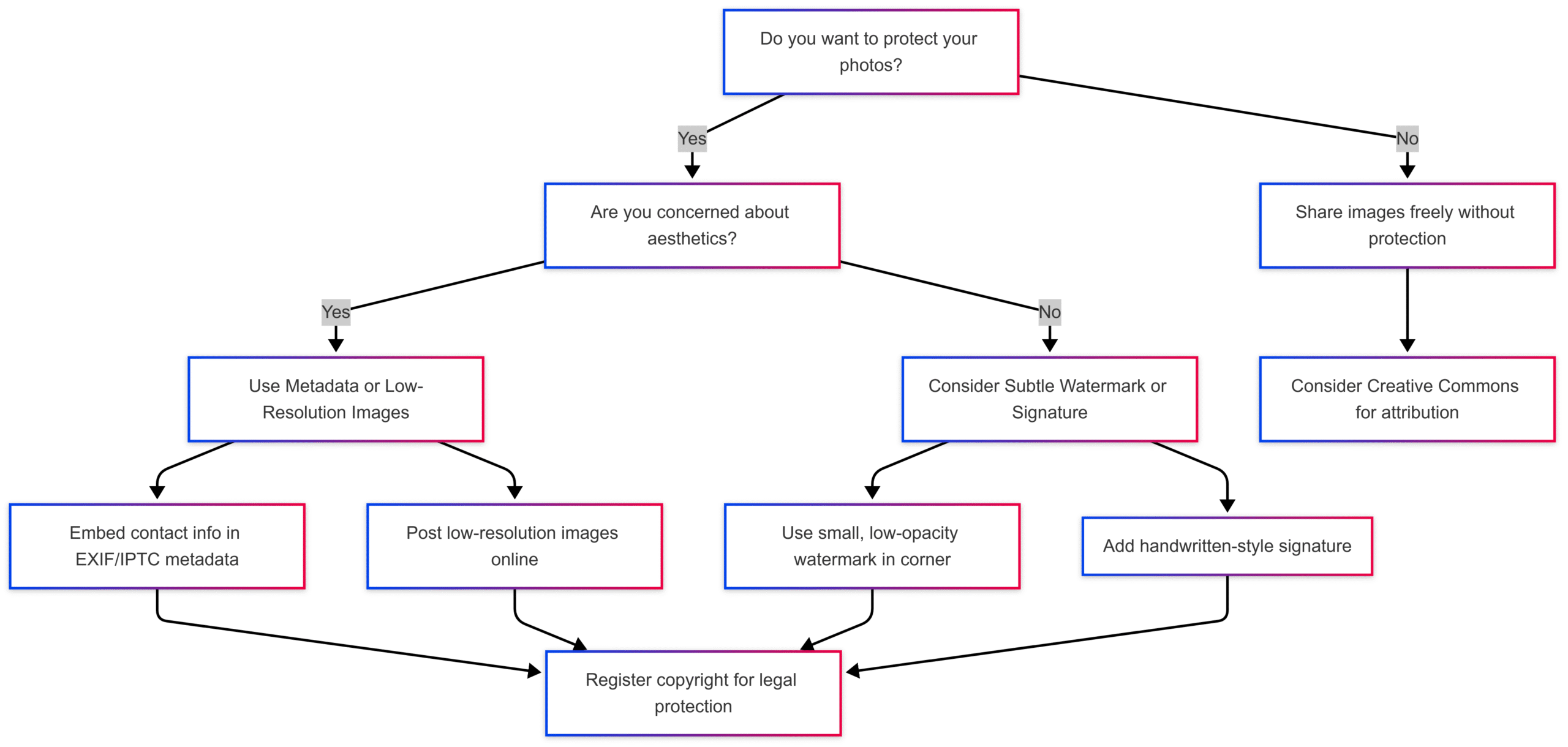Why you shouldn’t add a watermark to your photos
Discover why watermarks may harm your photography business. Learn the pros, cons, and alternatives to protect your images without compromising aesthetics.
Photography is an art form that thrives on visual impact, emotional resonance, and creative freedom. As photographers, we pour our hearts into capturing moments, crafting compositions, and perfecting edits to share our vision with the world. But when it comes to protecting our work, a common question arises: should you watermark your photos? While watermarks are often seen as a safeguard for photographers, they can do more harm than good in many cases. This article explores the reasons why you might want to skip watermarks, delving into their pros and cons, technological realities, and alternative strategies to protect your images while preserving their aesthetic integrity.
The Watermark Debate: A Polarizing Choice
The decision to watermark photos sparks heated discussions among photographers, from amateurs to seasoned professionals. Social media platforms like Reddit and Instagram are rife with debates, with some arguing that watermarks are essential for protection and branding, while others view them as tacky distractions that cheapen the image. The core issue lies in balancing the desire to protect your work with the need to present it in its purest form. This article argues that, in most cases, watermarks are unnecessary and potentially detrimental, especially for photographers aiming to build a professional reputation.
Why Photographers Watermark Their Images
Watermarks—typically a logo, name, or copyright symbol overlaid on an image—are used for several reasons. Let’s explore the primary arguments in favor of watermarking:
-
Copyright Protection
Watermarks are often seen as a deterrent against image theft. By marking an image with your name or logo, you signal ownership, making it harder for others to claim your work as their own. In legal disputes, a watermark can serve as evidence that you asserted your copyright, potentially strengthening your case against infringement. -
Branding and Recognition
A watermark can act as a calling card, helping viewers identify you as the creator. This is particularly useful on social media, where images are frequently shared without attribution. A subtle watermark with your name or website can drive traffic to your portfolio, potentially leading to new clients or followers. -
Preventing Unauthorized Printing
For photographers who rely on print sales, such as wedding or portrait photographers, watermarks on low-resolution digital files can discourage clients from printing these images themselves. This ensures that clients purchase high-quality prints directly from the photographer, preserving both revenue and image quality. -
Credit for Shared Content
In an era where images are reposted across platforms like Instagram, Pinterest, or Reddit, a watermark ensures that your name stays attached to your work. This can lead to organic exposure, as viewers who discover your image can trace it back to you.
The Case Against Watermarks
Despite these arguments, watermarks have significant drawbacks that often outweigh their benefits. Here’s why you might want to reconsider adding them to your photos:
-
Aesthetic Disruption
A watermark, no matter how subtle, draws attention away from the image itself. Large or poorly designed watermarks—think bold text across the center or garish logos—can ruin the viewer’s experience. Even a small watermark in the corner can distract from the composition, especially in genres like food or fine art photography, where visual purity is paramount. As one Reddit user, Brock_Hubble, put it, “I personally think it looks horrible. It takes so much away from the images.” -
Easily Removable
Advances in technology have rendered watermarks largely ineffective. Tools like Adobe Photoshop, Content-Aware Fill, or AI-powered apps like Remove.bg can erase watermarks in seconds. A small watermark in the corner can be cropped out, while larger ones can be removed with minimal effort by anyone with basic editing skills. As user Justgetmeabeer noted, “Any watermark that you can’t remove in five seconds in Photoshop is a watermark that will destroy the artistic value of the image.” -
False Sense of Security
Watermarks do not provide foolproof protection against copyright infringement. They may deter casual thieves, but determined infringers will not be stopped. Moreover, a watermark doesn’t legally prove ownership—only the original RAW file or metadata can do that. As user issafly commented, “Wouldn’t simply having the RAW source file with the original EXIF data cover you even better than a watermark?” -
Alienating Potential Clients
Watermarks can harm your brand by signaling insecurity or amateurism. Professional photographers like Paul Nicklen or Jimmy Chin rarely watermark their images, focusing instead on the strength of their work and reputation. A watermark, especially an obtrusive one, can turn off clients who value clean, professional imagery. One Reddit user, Any_Pin7820, shared, “As a client, I want to be able to own an unwatermarked digital photo of me and my family’s memories. I shouldn’t have to purchase prints directly from the photographer.” -
Limited Impact on Discoverability
The argument that watermarks help clients find you is weakened by modern technology. Tools like Google’s Reverse Image Search allow anyone to trace an image back to its source in seconds. Embedding metadata with your contact information is a less intrusive way to ensure discoverability without compromising the image’s aesthetics. -
Negative Perception in the Industry
Watermarks are sometimes associated with novice photographers who overestimate the value of their work. As user ColinShootsFilm bluntly stated, “It’s tacky and desperate.” While this view may be harsh, it reflects a sentiment among some professionals that watermarks can make you appear less confident in your work’s ability to stand out on its own.
Real-World Perspectives: What Photographers Say
The watermark debate has sparked lively discussions on platforms like Reddit, where photographers share their experiences and opinions. Here’s a snapshot of the community’s views:
- Anti-Watermark Sentiment: Many photographers argue that watermarks are unnecessary. User tinkafoo stated, “I never watermark anything, even photos on my website. If someone wants to steal the photo, a watermark won’t stop them. If someone wants to see the photo, a watermark will annoy them.” This reflects a common belief that watermarks prioritize ego over viewer experience.
- Pro-Watermark Arguments: Others see value in subtle watermarks for branding or legal protection. User jawanda shared, “My entire career has been made possible by posting my photos to Reddit and other platforms, and many have gone viral… leading to significant traffic thanks to my watermark.” Similarly, Ret_Cost_Emp emphasized the legal benefits, noting, “The important thing about watermarks… is to establish that it is YOUR work, which is an important part of winning a court case against infringement.”
- Middle Ground: Some photographers advocate for minimal watermarks. User FloridaManZeroPlan suggested, “Tiny, in the corner, 60% or less opacity. Your logo/watermark should be pretty and represent you and your brand.” This approach aims to balance branding with aesthetics.
To visualize the community’s sentiment, consider the following table summarizing a Reddit thread’s upvotes on key comments:
| Stance | Example Comment | Upvotes |
|---|---|---|
| Anti-Watermark | “I never watermark anything… a watermark will annoy [viewers].” (tinkafoo) | 276 |
| Pro-Watermark | “A small, subtle, unobtrusive watermark hurts nothing and guarantees people can find you.” (jawanda) | 13 |
| Neutral/Compromise | “Tiny, in the corner, 60% or less opacity… If you take your photography seriously, you’re a fool if you don’t watermark.” (FloridaManZeroPlan) | 5 |
This table highlights a stronger community preference for avoiding watermarks, though some support their use when done tastefully.
Alternatives to Watermarking
If watermarks aren’t the answer, how can photographers protect their work and ensure credit? Here are effective alternatives:
-
Embed Metadata
Embedding your name, contact details, and copyright information in the image’s EXIF or IPTC metadata is a non-intrusive way to assert ownership. Most photo editing software, like Adobe Lightroom, allows you to add this information automatically. Metadata can be viewed in various platforms and provides a digital footprint without altering the image’s appearance. -
Use Low-Resolution Images Online
Posting low-resolution images (e.g., 1080px or 2K at the widest) limits their usability for unauthorized printing or commercial use. As user FloridaManZeroPlan noted, “Any image you share online should be 2K pixels or less at its widest, so if someone does want to steal, they’re getting a shitty version.” -
Copyright Registration
Registering your images with a copyright office (e.g., via LegalZoom in the U.S.) strengthens your legal position in case of infringement. While not required to assert copyright, registration within 30 days of discovering misuse can enhance your ability to recover damages. User Ret_Cost_Emp emphasized, “You must go and register that image as copyrighted… you have 30 days from the time you discover the infringement to register the image or you have no hope of recovery in court.” -
Contracts and Licensing Agreements
For client work, use contracts that prohibit unauthorized use or printing of low-resolution files. Specify that clients must purchase high-resolution files for printing, ensuring control over quality and revenue. -
Creative Commons Licensing
Posting images under a Creative Commons license allows you to specify terms of use, such as requiring attribution. As user Fun-Background-9622 suggested, “Post under Creative Commons? Free use if credit is given. At least your name will get out there.” -
Subtle Signatures
Instead of a traditional watermark, consider adding a small, handwritten-style signature in a corner at low opacity. This mimics the approach of painters and printmakers, as user RefuseAmazing3422 noted: “Do painters, illustrators, printmakers etc. watermark their work? Generally, yes, they will leave their signature somewhere on the image.”
The following chart illustrates a decision-making process for protecting your images:

Context Matters: When Watermarks Might Make Sense
While this article argues against watermarks in most cases, there are scenarios where they may be appropriate:
- Social Media Sharing: A subtle watermark can help with branding on platforms where images are frequently reposted. User jawanda’s success with viral images underscores this: “Many have gone viral… leading to significant traffic thanks to my watermark.”
- Proofing for Clients: Wedding or portrait photographers often watermark low-resolution proofs to prevent clients from using them without payment. User a_loveable_bunny shared, “I do two versions when I export—one with, one without. Paying clients get both versions. Non-paying clients get only the watermarked versions.”
- Niche Markets: In fields like cosplay or historical photography, where content is rare and reposting is common, watermarks can deter theft and enhance credibility. User iCastleBravo noted, “With our work, we have noticed that watermarks do actually make an enormous difference.”
However, even in these cases, watermarks should be subtle, tasteful, and strategically placed to minimize distraction.
The Bigger Picture: Focus on Your Art
Watermarks often stem from a fear of losing control over your work, but this fear can overshadow the true purpose of photography: creating and sharing art. By focusing on building a strong portfolio, leveraging metadata, and using legal protections like copyright registration, you can safeguard your images without compromising their visual impact. As user Toaist eloquently put it, “My goal personally is for my work to stand out enough on its own that people will see it and think it might be mine.”
Practical Tips for Photographers
To wrap up, here are actionable steps to protect your images without watermarks:
- Batch-Process Metadata: Use software like Adobe Lightroom to embed your contact details and copyright notice in all images before sharing.
- Optimize Image Resolution: Share images at 1080px–2K resolution to limit unauthorized use while maintaining quality for online viewing.
- Secure Your Website: Disable right-click functions or use watermarked previews for portfolio images, as user soydberger suggested (though note that this can impact usability).
- Register Key Images: For high-value images, register copyrights promptly to strengthen legal recourse.
- Build a Strong Brand: Focus on creating recognizable work and a professional online presence, reducing the need for watermarks.
Conclusion
Watermarks may seem like a quick fix for protecting your photos, but they often do more harm than good. They can detract from your image’s beauty, alienate clients, and provide only a false sense of security in an age where AI and editing tools make removal effortless. Instead, embrace alternatives like metadata, low-resolution sharing, and copyright registration to safeguard your work while letting your art shine. The photography community’s debates highlight a clear divide, but the consensus leans toward prioritizing aesthetics and professionalism over obtrusive watermarks. Let your images speak for themselves, and trust that your talent and strategic protections will carry your brand forward.
What’s your take on watermarks? Share your thoughts in the comments below, and let’s keep the conversation going!
Please share these Why you shouldn’t add a watermark to your photos with your friends and do a comment below about your feedback.
We will meet you on next article.
Until you can read, The Benefits of Creating a Membership Site for Your Food Blog






